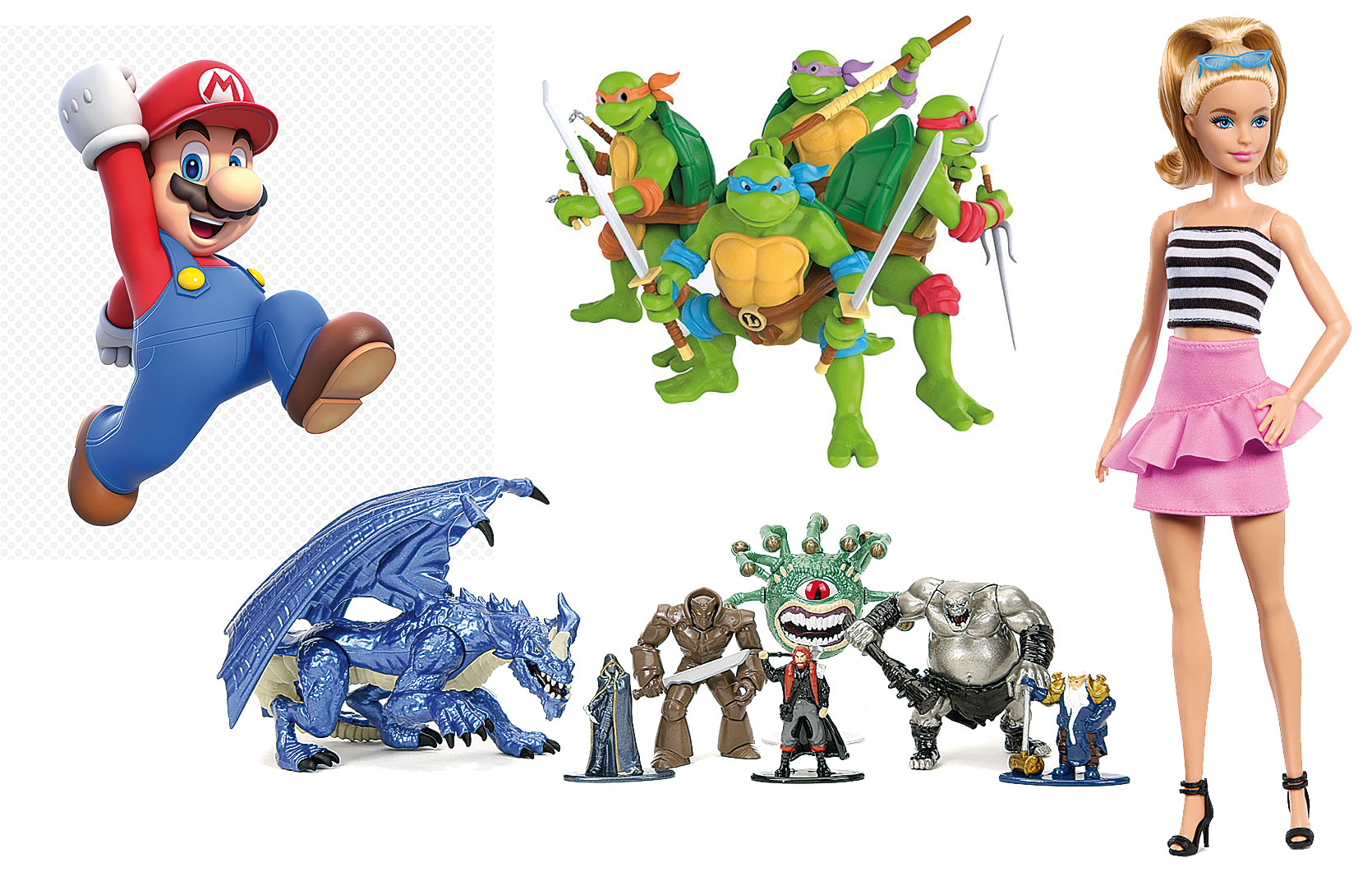The License GlobalToy Forecast / Die License Global Spielwarenprognose
From blockbusters to brand revivals and big kids, License Global breaks down key drivers for the licensed toy business in 2024.

Von Blockbustern über Markenrevivals bis hin zu großen Kindern: License Global schlüsselt die wichtigsten Treiber für das Lizenzspielzeuggeschäft im Jahr 2024 auf.
The global toy market is set to generate over 150 billion US dollar worldwide by 2028 according to data analysts Research and Markets, growing steadily with a compound annual growth rate of 6.8 percent. Licensed toys are forecast to play a critical role in that growth, generating 12 percent (42.7 billion US dollar) of the total reported worldwide licensing revenue of 340.8 billion US dollar in 2022 (Licensing International). The top five toy companies featured in License Global’s Top Global Licensors report generated 35.4 billion US dollar in licensed goods sold at retail, each seeing positive year-over-year growth. The brand licensing sector has been a critical part of the evolution of the global toy industry, and vice versa, and as both markets continue to grow, new trends are emerging every year that hint at the future of toys worldwide.
Following the success of “Barbie,” “Super Mario Bros. The Movie,” “Teenage Mutant Ninja Turtles: Mutant Mayhem” and “Dungeons & Dragons” this year, the trend of classic and long-standing intellectual properties taking both the box office and the toy aisle by force will continue. Intellectual property owners are increasingly engaging fans through milestone movies, series and short-form content, and given the entertainment arms of most major toy companies such as Hasbro, Mattel and Spin Master, we can expect to see toy brands continue to inspire more stories. Where the traditional licensing model bore a linear path (movie begets toy and so forth), the trend of toys inspiring entertainment franchises, such as games, movies and series, continues to act as a source of success.
The relaunch of nostalgia products and brands from the 80s and 90s is also a growing trend. After all, reviving a brand or celebrating a milestone anniversary appeals to both fans of the original and new audiences. As a result, we’re seeing a wide range of brands from Hasbro’s Furby and Bandai Namco’s Tamagotchi to Polly Pocket, Little People and Trolls all driving sales thanks to a multi-generational appeal and the ever-present power of nostalgia.
One particularly powerful trend, whether it’s steeped in nostalgia, collectability or multi-generational appeal, is kidult culture. Between 2000 and 2010, society began to embrace fandom and celebrate the connection we share with stories, brands and the sub-cultures of what was once considered “geek” – such as comic books, schlocky horror movies, pulp fiction, anime and video games – transforming fandom into a global zeitgeist for the new millennium. With this new era came a shared connection that grew with increased cultural acceptance of fandom and the ability to build communities in the developing social media age. This decade brought forth the era of the fan, and with it, a new consumer segment was born – the kidult. On the surface, “adults who buy toys” seems simple enough, but brands cannot underestimate the opportunity this sub-culture represents. According to NPD, kidults were the most significant consumer segment for toys in 2022, responsible for one-quarter of the year’s total revenue (9.3 billion US dollar) in the U.S. alone. In an interview with the Wall Street Journal, Chris Cocks, chief executive officer, Hasbro confirmed the importance of the market, stating that 40 percent of the company’s current consumer base is aged 18 and over. This cultural phenom holds such potential that it has become a part of prominent brand owner, licensee and retail strategy worldwide and an undeniable driver in the future of toys, collectibles and games.
Der globale Spielwarenmarkt wird nach Angaben des Marktforschungsunternehmens Research and Markets bis zum Jahr 2028 weltweit mehr als 150 Milliarden US-Dollar erwirtschaften und dabei mit einer durchschnittlichen jährlichen Wachstumsrate von 6,8 Prozent stetig wachsen. Prognosen zufolge wird Lizenzspielzeug bei diesem Wachstum eine entscheidende Rolle spielen, da es zwölf Prozent (42,7 Milliarden US-Dollar) der gesamten weltweit gemeldeten Lizenzeinnahmen von 340,8 Milliarden US-Dollar im Jahr 2022 generieren wird (Licensing International). Die fünf größten Spielzeugunternehmen, die im Bericht „Top Global Licensors“ von License Global aufgeführt sind, erzielten einen Umsatz von 35,4 Milliarden US-Dollar mit lizenzierten Produkten, die im Einzelhandel verkauft wurden, und verzeichneten alle ein positives Wachstum im Vergleich zum Vorjahr. Der Sektor der Markenlizenzen ist ein entscheidender Teil der Entwicklung der globalen Spielwarenindustrie und umgekehrt, und während beide Märkte weiter wachsen, tauchen jedes Jahr neue Trends auf, die einen Hinweis auf die Zukunft der Spielwaren weltweit geben.
Nach dem Erfolg von „Barbie“, „Super Mario Bros. The Movie“, „Teenage Mutant Ninja Turtles: Mutant Mayhem“ und „Dungeons & Dragons“ in diesem Jahr wird sich der Trend fortsetzen, dass klassische und langjährige geistige Eigentumsrechte sowohl die Kinokassen als auch die Spielzeugregale erobern. Die Eigentümer von geistigem Eigentum binden ihre Fans zunehmend durch Filme, Serien und Kurzfilme, und da die meisten großen Spielzeughersteller wie Hasbro, Mattel und Spin Master auch in der Unterhaltungsbranche tätig sind, können wir davon ausgehen, dass Spielzeugmarken auch in Zukunft weitere Geschichten inspirieren werden. Während das traditionelle Lizenzierungsmodell einen linearen Weg vorsah (Film zeugt Spielzeug und so weiter), ist der Trend, dass Spielzeug Unterhaltungsfranchises wie Spiele, Filme und Serien inspiriert, weiterhin eine Quelle des Erfolgs.
Die Wiederbelebung von Nostalgieprodukten und Marken aus den 80er und 90er Jahren ist ebenfalls ein wachsender Trend. Schließlich spricht die Wiederbelebung einer Marke oder das Feiern eines runden Geburtstages sowohl die Fans des Originals als auch neue Zielgruppen an. Das Ergebnis ist eine breite Palette von Marken, von Hasbros Furby und Bandai Namcos Tamagotchi bis hin zu Polly Pocket, Little People und Trolls, die alle dank ihrer generationsübergreifenden Anziehungskraft und der allgegenwärtigen Macht der Nostalgie den Umsatz steigern.
Ein besonders starker Trend, der von Nostalgie, Sammelleidenschaft und generationenübergreifender Anziehungskraft geprägt ist, ist die Kidult-Kultur. Zwischen 2000 und 2010 begann die Gesellschaft, das Fandom anzunehmen und die Verbindung zu feiern, die wir mit Geschichten, Marken und den Subkulturen dessen teilen, was einst als „Geek“ galt – wie Comic-Bücher, Schlocky-Horror-Filme, Pulp Fiction, Anime und Videospiele – und verwandelte das Fandom in einen globalen Zeitgeist des neuen Jahrtausends. Mit dieser neuen Ära entstand eine gemeinsame Verbindung, die mit der zunehmenden kulturellen Akzeptanz des Fandoms und der Möglichkeit, im aufkommenden Zeitalter der sozialen Medien Gemeinschaften zu bilden, wuchs. Dieses Jahrzehnt brachte die Ära der Fans hervor, und mit ihr wurde ein neues Verbrauchersegment geboren – der Kidult. Oberflächlich betrachtet scheint „Erwachsene, die Spielzeug kaufen“ einfach genug zu sein, aber Marken dürfen die Möglichkeiten, die diese Subkultur bietet, nicht unterschätzen. Laut NPD waren Kidults im Jahr 2022 das bedeutendste Verbrauchersegment für Spielwaren, das allein in den USA für ein Viertel des Gesamtumsatzes (9,3 Milliarden Dollar) verantwortlich war. In einem Interview mit dem Wall Street Journal bestätigte Chris Cocks, Chief Executive Officer bei Hasbro, die Bedeutung dieses Marktes und erklärte, dass 40 Prozent der derzeitigen Kundenbasis des Unternehmens 18 Jahre und älter sind. Dieses kulturelle Phänomen birgt ein derartiges Potenzial, dass es zu einem Teil der Strategien prominenter Markeninhaber, Lizenznehmer und Einzelhändler weltweit geworden ist und unbestreitbar die Zukunft von Spielzeug, Sammlerstücken und Spielen bestimmt.

Toys are also becoming more accessible, a movement of vital importance for the global consumer base. License Global’s Ian Hart explored how toy brands have begun to make strides toward making more accessible toys thanks to increased visibility surrounding developmental differences in kids. TheSoul Publishing has teamed up with BunMo for a special sensory toy, and Lego continues to build out its toy therapy program. Clothing brands have also joined the movement, with Thomas & Friends, the National Autistic Society and Character.com creating autism-friendly pajamas to help kids avoid some sensory discomfort.
These are just a few core trends driving the toy market forward, and License Global forecasts that licensing will continue to play a critical part in the evolution of the toy industry. When asked by License Global, 36 percent of the licensors featured in the Top Global Licensors report planned to expand into, or continue licensing within, the toy market in 2024/25. Of those respondents, 50 percent of brand owners forecasted an increase in the engagement between licensed consumer products and consumers across categories, a sentiment confirmed the rapidly growing licensing market highlighted in both the Licensing International Survey and the Top Global Licensors report. Delving deeper into growing trends within licensing, License Global asked manufacturers to state which new licenses and intellectual property portfolios they had signed in 2023 (so far), spotlighting Barbie, “Stranger Things” and Care Bears as the top three. These three properties were closely followed by the Disney and Marvel portfolios, Mattel’s range of properties, “Minecraft,” Warner Bros. and DC Comics roster of IP, Hasbro’s range of titles, Hello Kitty and “Wednesday.”
License Global, Brand Licensing Europe and Licensing Expo Las Vegas (along with the entire Global Licensing Group) are celebrating this in 2024 with our undercurrent theme of “Brands at Play,” a dedicated look at the concept of play with a focus on sports, gaming, toys and much more. Stay tuned to License Global for dedicated “Brands at Play” columns, supplements aimed at the evolution and innovation of core-categories within the business of ‘play’ and many more trend and data-driven insights into the world of licensing.
The Top Global Licensors and Leading Licensees reports can be found at License Global (licenseglobal.com) with more information on Brand Licensing Europe and Licensing Expo Las Vegas at thegloballicensinggroup.com
Auch Spielwaren werden immer zugänglicher, eine Entwicklung, die für den weltweiten Verbraucherstamm von entscheidender Bedeutung ist. Ian Hart von License Global hat untersucht, wie Spielzeugmarken dank der zunehmenden Aufmerksamkeit für Entwicklungsunterschiede bei Kindern begonnen haben, zugänglichere Spielzeuge zu entwickeln. The Soul Publishing hat sich mit BunMo zusammengetan, um ein spezielles sensorisches Spielzeug zu entwickeln, und Lego baut sein Spielzeugtherapieprogramm weiter aus. Auch Bekleidungsmarken haben sich der Bewegung angeschlossen: Thomas & Friends, die National Autistic Society und Character.com haben autismusfreundliche Schlafanzüge entwickelt, die Kindern helfen, sensorische Beschwerden zu vermeiden.
Dies sind nur einige der Haupttrends, die den Spielwarenmarkt vorantreiben, und License Global prognostiziert, dass die Lizenzierung weiterhin eine entscheidende Rolle bei der Entwicklung der Spielwarenindustrie spielen wird. Auf die Frage von License Global planten 36 Prozent der im Bericht „Top Global Licensors“ genannten Lizenzgeber, im Jahr 2024/25 in den Spielwarenmarkt zu expandieren oder dort weiterhin Lizenzen zu vergeben. Von diesen Befragten prognostizierten 50 Prozent der Markeninhaber eine Zunahme des Engagements zwischen lizenzierten Konsumgütern und Verbrauchern über alle Kategorien hinweg, eine Einschätzung, die den schnell wachsenden Lizenzmarkt bestätigt, der sowohl in der Licensing International Survey als auch im Top Global Licensors Report hervorgehoben wird. Um die wachsenden Trends im Bereich der Lizenzierung genauer zu untersuchen, hat License Global die Hersteller gebeten, anzugeben, welche neuen Lizenzen und Portfolios für geistiges Eigentum sie im Jahr 2023 (bisher) unterzeichnet haben, wobei Barbie, „Stranger Things“ und Care Bears als die drei wichtigsten genannt wurden. Dicht gefolgt von den Portfolios von Disney und Marvel, der Produktpalette von Mattel, „Minecraft“, der IP-Liste von Warner Bros. und DC Comics, der Produktpalette von Hasbro, Hello Kitty und „Wednesday“.
License Global, Brand Licensing Europe und Licensing Expo Las Vegas (zusammen mit der gesamten Global Licensing Group) feiern dies im Jahr 2024 mit dem Unterthema „Brands at Play“, einem speziellen Blick auf das Konzept des Spielens mit Schwerpunkt auf Sport, Gaming, Spielzeug und vieles mehr. License Global hält auf dem Laufenden was spezielle „Brands at Play“-Kolumnen, Ergänzungen, die auf die Entwicklung und Innovation von Kernkategorien innerhalb des Geschäftsfelds „Spiel“ abzielen, und viele weitere trend- und datengestützte Einblicke in die Welt der Lizenzierung betrifft.
Die Berichte über die Top Global Licensors und die führenden Lizenznehmer gibt es bei License Global (licenseglobal.com), weitere Informationen über Brand Licensing Europe und die Licensing Expo Las Vegas unter
Ben Roberts

